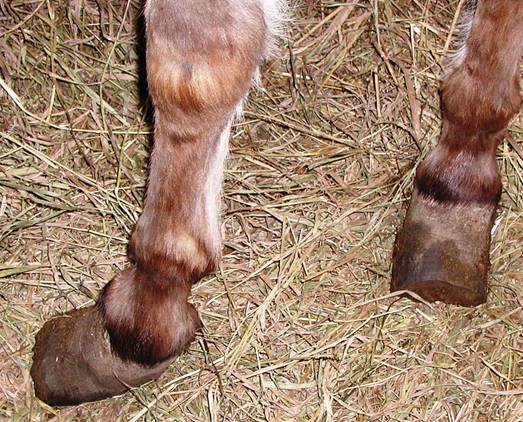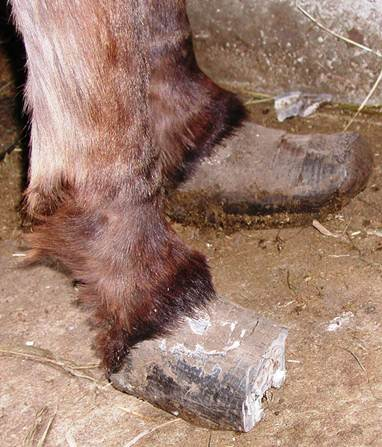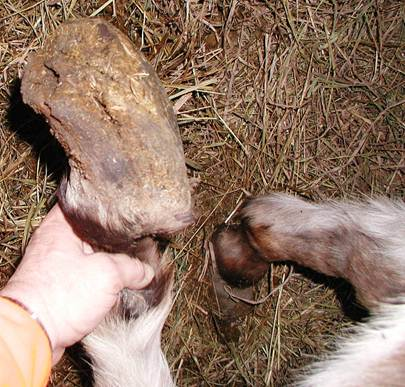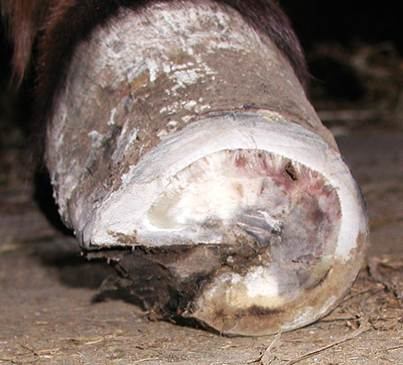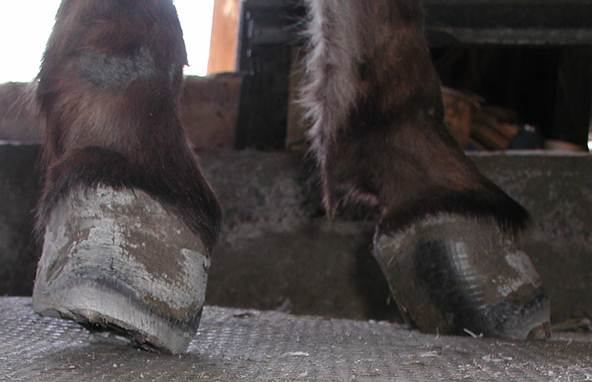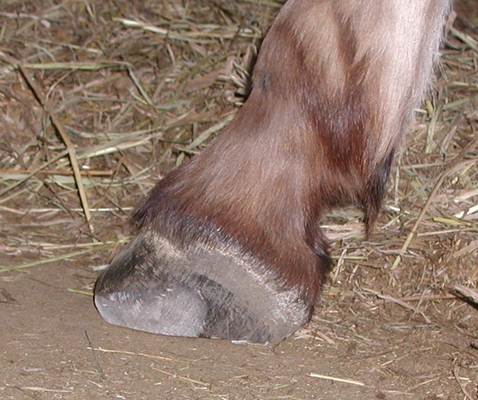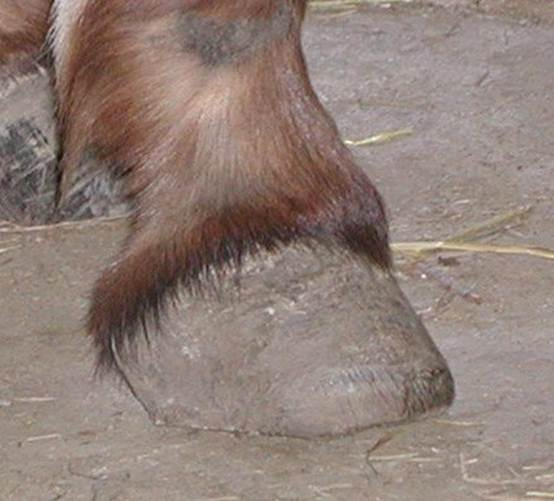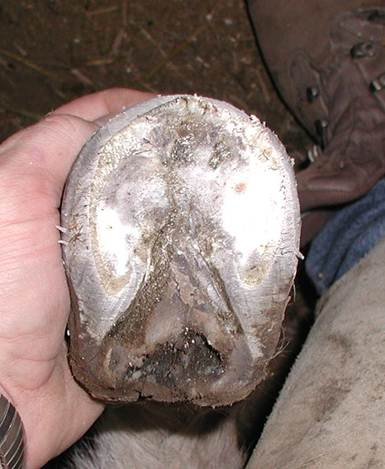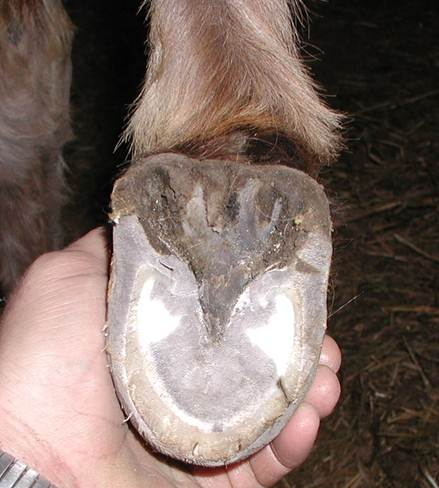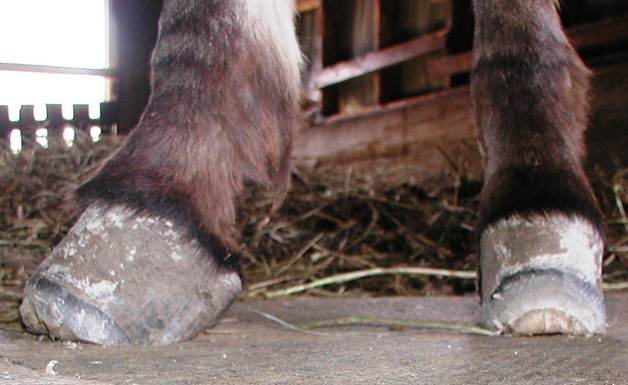CodyFoundered donkey given up by vets and farriersCody had been seen by two farriers, a husband and wife team. They attempted to trim Cody as you can see in the photo below. They started to trim off the toe but did not know how to trim such an overgrown hoof. I was told by the owner that these two farriers told the owner to put the burro down as he was in severe pain and his feet could not be repaired and then left. The owner called me and asked if I would come take a look. When I arrived, I took this photo of the front feet. This was my first case of trimming such a severe hoof case. I knew I could do it but had some questions, so I decided to take some photos and consult with Heike Bean and Marjorie Smith over the internet. These two ladies did not know me and had no idea who I was, but agreed to help me through this. These two ladies were wonderful in helping me trim Cody through their guidance, advice and encouragement via email. When I arrived, I found Cody had some severely overgrown hooves but he did not appear in extreme pain. In fact he was walking (as best he could) and even sparring with his other equine buddies. I could pick up his feet and he could stand fairly well as I trimmed him. He did have difficulty standing on his right front foot so I took turns working on the fronts. I would work on the left for a couple minutes then go to the right, back and forth until I got his front feet back under him. Then he stood much better. The inside hoof wall on his right front foot had collapsed under his foot and was rolled under. He was walking on the side of his foot and his right front foot was turned out. During trimming on this foot, I found the coffin bone had partially penetrated the sole. Even with this partial penetration, Cody walked very well after he was trimmed Front hooves as Randy met him 2 years ago
I used my nippers to remove the overgrown toe taking off one layer at a time. Since this was my first case of such overgrown hooves, I wanted to take it slow. Plus by removing a little at a time, it allowed me to see what was happening, to view and study each cut, to take photos and explain to the owner what I was doing what had happened to the hooves and point out the different parts of the hoof. Hind hooves after the toe was cut off partially of the RH
Right front The right front foot presented more of a challenge for me. Not only was the hoof extremely overgrown, the inside of the hoof wall had collapsed under the foot and continued to grow rolling the foot onto its side and forcing the foot to turn out. It was hard to recognize much under the foot as everything had overgrown. In the photo you can see how the inside of the hoof wall is collapsed under the foot, the frog is nearly covering the bottom of the foot and you can see an extremely deep frog central sulcus.
This is the right front foot as I was backing up the toe. I did this with my nippers slowly removing a layer at a time. This let me get a better understanding of what had happened and how the internal structures had fallen apart. It was an experience making these cuts and seeing the internal damage first hand. I had to explain to the owner that the red blood was encapsulated blood from previous tears and damage and that Cody was fine.
In these two photos, I have removed much of the overgrowth to allow Cody to get his foot back under his leg. This allowed him to stand better for the rest of the trim. I worked back and forth on the front feet so that Cody would be more comfortable while I removed the overgrown material until I was able to get his feet back under him. I have not yet lowered or balanced the heel. In both the front and back views of this foot, you can see how the inside of the hoof wall is rotating under the foot and how the foot has been forced to turn out.
In this photo I am lowering and balancing the heels which made it even more comfortable for Cody to stand.
This is the right front foot after I was done. I think I had the foot balanced well and had removed most of the lamellar wedge around the foot. I left maybe 1/4 to 3/8 inch of lamellar wedge for support and to allow an area of load bearing for this foot. The foot and leg were still turning out, but over time this foot and leg straightened out and today (April 2012) are in very good shape with only a slight outward turn.
This photo was taken of the underside of the right front foot 4 days after I trimmed the foot. During the initial trim, I found that the coffin bone had partially penetrated the sole. I was concerned about this and checked Cody for soundness after I finished his trim. He walked fine and did not favor the right front foot so I left him barefoot. I asked the owner to watch this foot carefully. I went back 4 days later to check on Cody and examine the coffin bone penetration. I was surprised but very happy to see how much the sole had already healed over this area where the penetration had occurred. Another thing you can notice in this photo is that there are still no real collateral grooves. It took me several trims to really get those grooves open and back in shape.
Left Front I started working on this foot first because it looked a little easier to do than the right front foot. The two photos below show some of my very first cuts that I made backing up the toe. I did these with my nippers while Cody was standing on his foot. I removed as much as I could before having to pick up his feet to work on them. After my first cuts, I had to stop and study what I was seeing. I had never witnessed this first hand. It was exciting to see, but the biggest reward was when I was finished and Cody was standing comfortably with all four feet back under him.
The left front foot was easier for me to get back in shape than the right front foot. In the photo of the underside of this foot you can see that I left some lamellar wedge material for support. The frog was so packed into the collateral grooves that it was difficult to get them cleaned out and defined. In fact, it was several trims later before the grooves were looking normal again. In addition, thrush had eaten away at the heel bulbs at back of the frog. I cleaned this out and asked the owner to treat/soak this area with a 50/50 mix of apple cider vinegar and water.
The foot after completing the trim. You can see that the lower hoof wall at the toe is made up of lamellar wedge material. This material will be there until the hoof wall grows down tight and well connected.
Right hind This is Cody in his elf shoes. Unfortunately it is his real foot and a very serious situation. I am proud to say that this foot was back to normal looking in a short time. Again, I worked on the back feet together for a couple minutes at a time to keep Cody from having to stand on a foot for very long. It worked out well. In this photo you can see where a previous farrier attempted a trim but realized it was too much for them and stopped.
Here is the bottom of the foot. Looking at the bottom of Cody’s feet was a very different experience. Everything was so overgrown that it was at first difficult to recognize anything. But with a little cleanup and cutting some of the overgrown frog and bars out of the way, the foot structure started coming clear.
Again, I used my nippers to cut back the toe while Cody was standing on his foot. I was able to get a tremendous amount of growth off in this way and it reduced the stress on Cody’s feet and legs. Again, these initial cuts were mesmerizing. Each layer I took off I had to stop and examine.
The back feet took shape faster, maybe because I had completed the two front feet and had a little more knowledge. It is amazing how much knowledge you gain trimming a case like this and how much clearer the structure of the foot becomes when you are the person running the tools trimming the foot. Here I have the foot back in shape and I am working on the bottom. This photo shows the extent of the separation between the epidermal laminae and the sole. There is still a thin layer of hoof wall visible at the toe.
The back right foot at the end of the trim. This made me smile (and the owner too).
Both hinds Photos of the back feet during the trimming process. Here I have them back under Cody but have more trimming and shaping to do. In the view from the front, you can clearly see that the lower hoof wall will be made of Lamellar wedge until a new tight well connected hoof wall is able to grow down. The lamellar wedge material will still provide support and load bearing duties for the hoof. It may not look pretty but Cody loved it.
Cody today This photo is Cody 2 years after that first trim I did for him. I am still trimming Cody on a 6 week schedule. Cody is still allowed to graze rich sugar filled grass which is his worst enemy. I am able to keep the feet in shape but due to the rich sugar filled diet that Cody is still on, there is still laminar separation at every trim. The separation is much less than in those first few months of trimming, but it is probably going to be impossible to grow a tight well connected hoof wall due to the sugar in his diet. A diet change must happen before the separation will go away. Cody shows the classic fat deposits of a diet not suited for a burro. Even though Cody still exhibits separated laminae, I do not see any pain distress in him. He has become a very good patient and stands well for me. I enjoy visiting him. I owe a tremendous amount of thanks to Cody. He probably does not know it but he taught me a great deal about feet. He made me smile. I want to thank Heike and Marjorie too. Their advice, guidance and encouragement made this trim possible. Thank you ladies. I want to thank the owner too for trusting me enough to help Cody.
|
